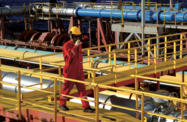Officials are looking at a 2014 start date for a major new mining venture, with plans moving forward for the Kingdom to cooperate with Sudan to exploit deposits deep beneath the Red Sea.
Plans for the two neighbours to jointly develop the 2000-metre-deep Atlantis II basin, located between Jeddah and Port Sudan, have been in the pipeline for some time. Indeed, the two countries first signed an agreement to work as partners in the exploitation of the basin in 1974. In late November, Saudi Arabia’s Petroleum and Mineral Resources Minister, Ali Al Naimi, announced that the project to develop the undersea field was formally under way and cited the scheme as an example of Arab cooperation, one that could be followed by other states in the region.
While Sudan is looking to offset the lost revenue resulting from the creation of South Sudan, with the new state controlling most of the oil reserves that previously propped up the economy, Saudi Arabia’s aim is to expand its own mining sector and to diversify the economy away from a hydrocarbons dependency.
Canadian firm Diamond Fields International (DFI) – which along with the Manafa International Trade Company of Saudi Arabia was granted a licence to conduct feasibility studies of the basin – is conducting a study on whether the project can be carried out safely and profitably and what the full extent of the deposits could be.
Previous studies have suggested that the undersea deposits could yield up to $8bn or more worth of minerals, including gold, copper, zinc and silver. One estimate has put the gold deposits at 150 tonnes, and there could be up to 1m tonnes of copper, though other surveys indicate the copper deposits could be around half of that.
The environmental impact of the development is an issue the study will also address, as there are concerns the delicate ecosystem both on the seabed itself and in the waters above it could be harmed. Experts have warned that the use of toxic substances, such as mercury, would have to be avoided lest any leak damage the environment of the region.
Extensive investment would need to be made before extraction could begin, too. Some estimates put project set up costs at hundreds of millions of dollars. Despite the potential profits on offer, far more money would have to be ploughed into the venture to take advantage of whatever undersea mineral wealth does exist.
As neither country has a copper smelter, they would either have to build a facility or export the raw material from their mining operations for processing. The former would offer the opportunity for value-added production and exports and would be in keeping with the Saudi Arabia’s policy of maximising earnings from its natural resources.
Experts estimate the cost of a copper smelter at around $2bn. Given that Saudi Arabia already has extensive copper reserves, the construction of a smelter would make economic sense. Studies have already been carried out as to the optimum location for a smelter, with most of the sites close to the Red Sea coast, which would facilitate easy access from the underwater fields and also for most of the ore deposits on the mainland, located in the north-west of the country.
Locating the smelter close to the Red Sea would also speed up the export process, as movements from the facility to ports along the coast would be further eased by the network of broad-gauge rail lines being developed by the government. One of the advantages already identified by DFI is the proximity of the fields to the Saudi and Sudanese coasts, meaning the cost of transporting the raw materials to shore could be kept low.
Even at $2bn, the cost of the smelter would be low compared to other investments being made in the mining industry. According to Al Naimi, Saudi Arabia intends to invest $50bn in the sector and, to date, has already granted more than 1700 mining licences covering an area of 73,000 km, with more under consideration.
If the joint development proves successful, it could lead on to the development of other projects in the Red Sea with the Kingdom’s other neighbours, potentially unlocking a technology transfer and broadened skills base.

